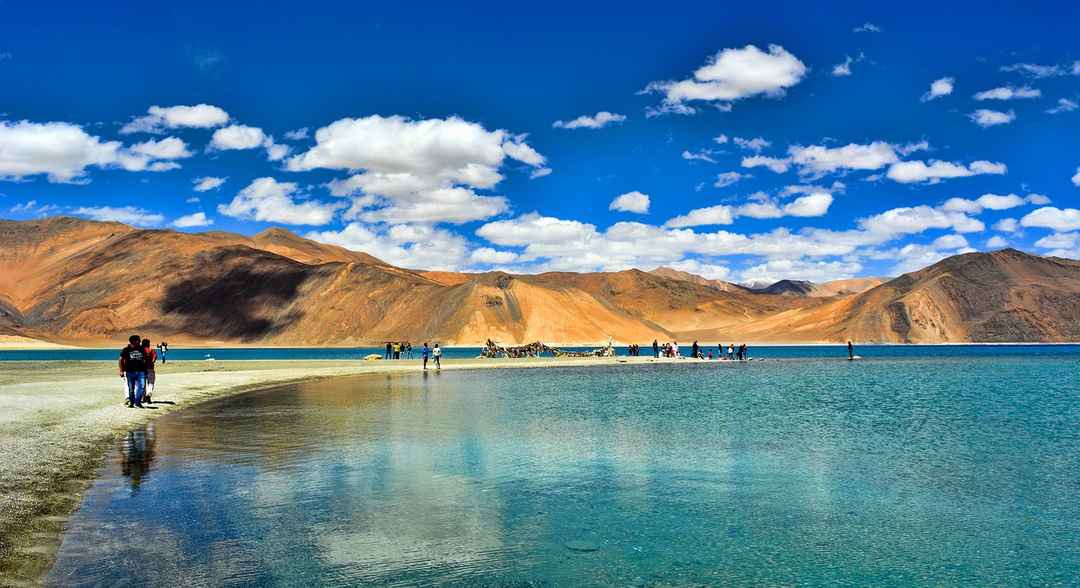Looking forward to exploring the high passes, Buddhist monasteries, tiny hamlets and local culture of Ladakh!? Here’s everything you need to know about the place!
Along the long-established trade routes through Tibet, Central Asia, Kashmir and the plains of northern India, came not only goods but also ideas. Despite its harsh terrain and remoteness from urban centers, Ladakh has long been a location where people, commerce and cultures intermingled and its art forms, therefore, reflect influences from many other places. Places like Shanti Stupa, Leh Palace and the old town in Leh are worth a visit to explore the true beauty of Leh-Ladakh.
Must Read-Longest Rivers In India
Hall of Fame located near Leh Airfield is a museum maintained by the Indian Army
in the memory of the brave soldiers who sacrificed their lives for protecting our country. Filled with information and artifacts related to cross-border wars, the museum is a wonder in itself.
Stok Palace which is located at a distance of 15 KM from Leh city, is 190 years old, as the construction of the palace was completed in 1825. It is considered as an excellent example of 18th century Tibetian architecture.
Leh Palace is a 17th-century palace constructed during the ruling of King SenggeNamgyal. The 9-
story building is a famous spot amongst tourists and offers an excellent view of the valley from the roof-top.
Shanti Stupa was inaugurated by the Dalai Lama in 1985 and is a snow-white dom- shaped structure constructed for celebrating the completion of 2500 years of Buddhism. It looks extremely beautiful on a full-moon night.
The major religious end of Ladakh is Buddhism and the place has several peaceful and beautiful monasteries.
Hemis Monastery which was constructed in 1672 during the reigns of King SinggeNamgyal, is not only the largest monastery in the entire Leh-Ladakh region but also the most famous of all Buddhist monasteries in the vicinity.
Diskit Monastery is a 700 years old structure replicating the architecture of the famous Tashilhunpo Monastery in Tibet. It is considered to be the oldest and the largest monastery in the Nubra Valley region.
Thiksey Monastery is one of the oldest monasteries in Leh district, known for its magnanimous statue of 15 meters high Maitreya Buddha – which is portrayed as seated in the lotus position rather than his usual representations in a standing posture.
Rangdum Monastery is situated at a mystical location alongside a mountain stream and surrounded by snowy peaks. Centrally located on an ascending mountain top, it offers amazing views of the villages in the distant Padum Valley.
Other monasteries of high order and stature include Spituk monastery, Phugtal Monastery, SheyMonastery, PhyangMonastery, Stakna Monastery, etc.
Related- 10 Peaks in India
Trekking and camping
Leh-Ladakh sleeps in the shadow of a million clearly visible stars. It’s one of the best places in the world for trekking and camping. A variety of treks are common in the place.
Zanskar Valley is one of the most isolated yes magnificent places to visit during your Leh-Ladakh tour. The place has no connectivity for over 8 months a year to the rest of the region due to heavy snowfall. The confluence of Zanskar and Indus rivers offers white water rafting opportunity – which is regarded as the best river rafting facility in India.
Sham Trek is one of the beginners. It is one of the easiest routes in the Ladakh region, it is an ideal trek for getting an insight into the culture and lifestyle of the residents of Ladakh.
Henaskut to Wanla trek goes through a number of high altitude mountain passes and the whole journey with beautiful landscapes can be covered in 6 days with adequate rest.
Kangyatse Peak and Markha Valley trek is a famous trail for the trekkers, considering the topography of Kangyatse, the level of difficulty is quite high in this trek. It takes around 9 days to cover the entire journey.
Suru valley and Nun Peak trek are regarded as the most challenging and beautiful of all treks in Leh-Ladakh region, this scenic route is a favorite among the professional and amateur European mountaineers.
Chadar Trek originates from the Chilling village and is strictly for the adventure lovers with prior trekking experience. This trek is considered as one of the most scenic treks as it is mostly covered in snow. Chadar trek would take 9-10 days and it covers a total distance of about 75Kms.
Related- Top Youth Hostels in India for Solo Travellers.
Other treks include Lamayuru to Padum, Rumtse to TsoMoririthrough YalangYugula pass, Tso Moriri to Parang La, Stok Mountain Range, etc
Lakes
A very famous shot from the Bollywood blockbuster 3 Idiots has been shot on one of the most beautiful sites in the country, Pangong Tso Lake, and remains in our hearts till today! Ladakh is filled with such peaceful and serene lakes where you could just spend your entire day away from every other thought! Situated at a height of 4,250 meters on the Changtang plateau in the eastern Ladakh region, Pangong Tso Lake, also known as the Hollow Lake, is a great testimony of nature and craftsmanship.
Tso Moriri Lake is the largest lake in the entire Ladakh region which attracts a large number of native and migratory birds. It faces a little resistance from tourists due to its distance from Leh – 250 km.
There are many other serene lakes in the beautiful land of Ladakh which will cool your soul and add a hundred stars to your trip. These lakes include TsoKar Lake, YarabTso Lake, etc
Mountain Passes
There are some mountain passes of great historical importance in terms of the trade market as they used to serve as the gateways between India and other neighboring countries for the exchange of essential goods. Khardung La is the world’s highest motorable pass situated at an elevation of over 5600 meters and is the doorway to Shyok and Nubra Valleys. Bikers from all over the world come to experience this place. Other mountain passes include Taglang La, with an elevation of 5328 meters above the sea level, Chang La, third highest motorable mountain pass in the world, also rated as a must-visit in Leh-Ladakh due to its barren landscapes decorated with snow-capped peaks and view of the undulating valleys underneath.
Cuisine
Ladakhi food has much in common with Tibetan food. They mostly constitute thukpa (noodle soup) and tsampa, known in Ladakhi as ngampe (roasted barley flour). Tsampa makes useful trekking food as it is edible without cooking.
Skyu is another strictly Ladakhi and a very famous dish in other words explained as a heavy pasta dish with root vegetables.
Yes, it’s time you stop hunting for a reason to go because there’s not one reason you shouldn’t! 


